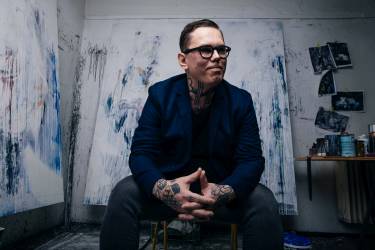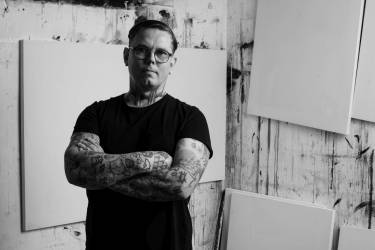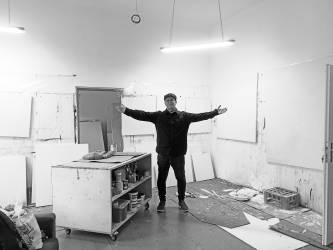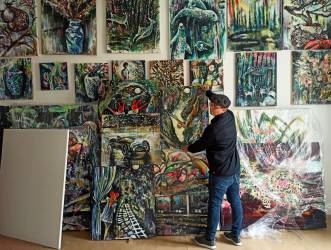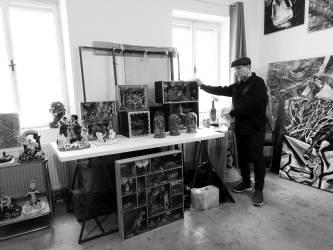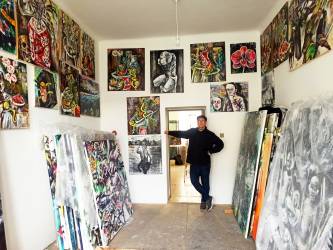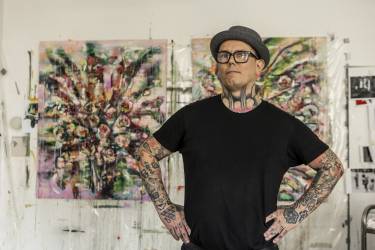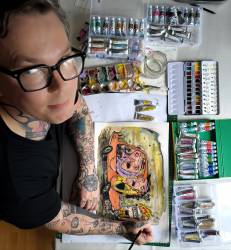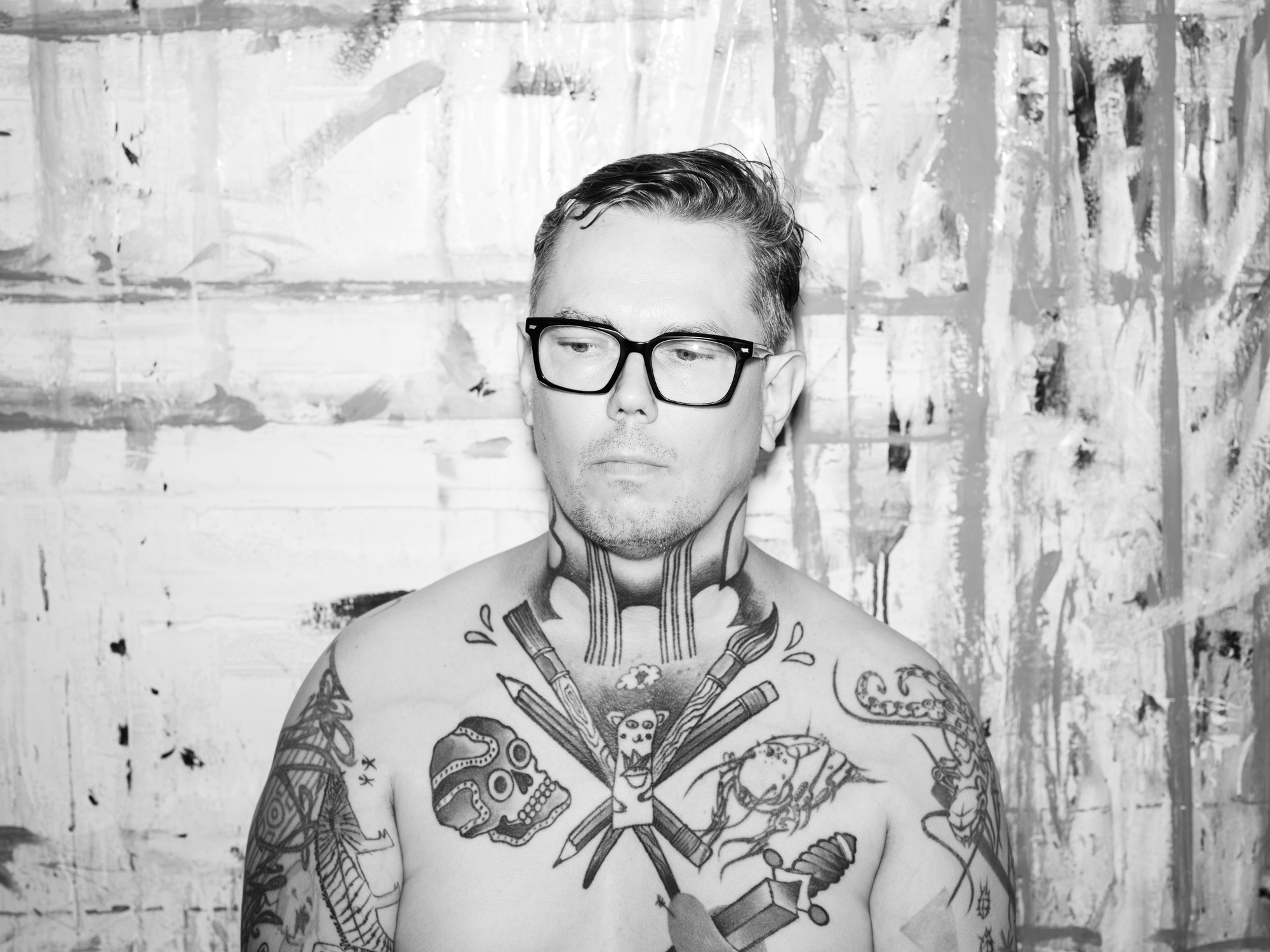
Marek Nenutil (1978), Czech Republic
Marek Nenutil (*1978), osobnost kdysi neodbytně spjatá s prostředím streetartu a graffiti (1993-2011), avšak odjakživa se věnuje malbě a různým výtvarným technikám a vyjádření. Prošel řadou uměleckých škol, například u garfického výtvarníka Jozefa Odrášky v Ostravě a Miroslava Bravence v Brně. Navštěvoval i ateliér malby prof. Daniela Balabána akad. malíře na Fakultě umění Ostravské univerzity.
Ilustroval knihy, časopisy, plakáty, namaloval desítky interiérů a exteriérů s celými vizualizacemi po celé České Republice. Vytvářel designy na trička, spolupracoval na několika výtvarných projektech. Dnes se volně a bravurně pohybuje na mezích současné dynamické figurativní malby, objektu a instalací. Vytváří také koláže, ilustrace, věnuje se keramice, fotografii a klasickým grafickým technikám.
Jeho díla jsou zastopena v mnoha českých i zahraničních sbírkách v USA v New Yorku, Seattlu, Novém Mexiku, Polsku, Německu, Taiwanu, Rakousku, Španělsku atd.
kurátor P. Kubesa
Marek Nenutil (*1978), a person once hauntingly connected with an czech world of streetart and graffiti (1993-2011), but it has always been devoted to painting and various art techniques and expression. He went through a number of art schools, for example, with graphic designer Jozef Odráška in Ostrava and Miroslav Bravence in Brno, he also visited the painting studio of Prof. Daniel Balbán, an academic painter at the Faculty of Arts of the University of Ostrava.
Illustrated books, magazines,posters, dozens of painted interiors and exteriors throughout with full vizualizations in the Czech Republice, creating designs on shirts, collaborated on several art projects. Today he freely and bravely moves on the limits of the current contemporary figurative painting, object and mixed - media installations. He also creates collages, illustrations, ceramics, photography and classical graphic techniques.
His works are represented in many Czech and foreign collections in the USA in New York, Seattle, New Mexico, Poland, Germany, Taiwan, Austria, Spain etc.
curator P. Kubesa
Text k Monografii
Marek Nenutil se nikdy příliš nezdržoval ani uměleckým vzděláváním, ani definicemi svého uměleckého jazyka. Jeho hlavním krédem je totiž přesvědčení, že dne a času je při tvorbě třeba využít na maximum bez ohledu na vnější okolnosti. Co v jeho vyjadřování platí právě teď, může být proto za den, měsíc či rok zcela jinak. Odbíhal a odbíhá od malby tam i jinam - k objektům, instalacím, ilustracím a různým dalším realizacím. Své vize a nápady přitom chrlil a chrlí na plátna, stěny i do prostoru se závratnou rychlostí. Dravě se dere za výrazem. Touží se vyjádřit přímo, ale i parafrází či symbolickým jazykem k celé řadě aktuálních společenských témat sahajících od tematizace násilí až po klimatickou změnu. Vedle malovaných figurálních kompozic inspirovaných třeba starými fotografiemi a retro vizualitou čtyřicátých a padesátých let minulého století či krajinných motivů tak aktuálně vytváří i fascinující apokalyptické či panoptikální objekty - asambláže pulsující neobyčejnou narativní silou nutně přitahující pozornost každého, komu se dostanou do zorného pole.
Maloval a kreslil od mládí. Hledal se. Bloudil. Bloudil ale odvážně a zajímavě. Ve svých raných uměleckých pokusech (od roku 2003) chtěl možná zaujmout za každou cenu tak jako asi každý teenager. Už tehdy se ale nechtěl a neuměl podbízet. Neřešil, jak bude to, co dělá, přijato. Někdy poněkud infantilní tematika snad mohla vyznívat spíš jako pubertální výstřelky než jako seriózně myšlené hledání výrazu, ale tendence ke zkratce a schopnost vypointovat zobrazované, tak jak to můžeme vidět v jeho osobitě stylizovaných ilustracích či návrzích z té doby, jsou už i na těchto raných pracích patrné a ne náhodou se stanou důležitou součástí jeho tvorby v dalším období. V těchto raných pokusech máme co dočinění s vypravěčem, který by dokázal pracovat i s komiksovou estetikou. Je vlastně až divné, že si komiks ještě nezkusil.
Vedle práce s kresebnou linkou se postupně a stále více odvažoval využít i větších malířských formátů. Zaujalo ho nejdřív hlavně graffiti a street art. Zabýval se jimi intenzivně až do roku 2014, kdy (patrně ze zdravotních důvodů) přešel k závěsnému obrazu. Občas se v tomto streetovém období pohyboval na poli abstraktního vyjadřování. Vyprávěcí linka ale zvolna začínala nabírat na síle i na jeho nástěnných realizacích a nakonec se stala nejcharakterističtějším prvkem jeho “zralé” a dnes už i rozsáhlé malířské tvorby stejně jako další typické znaky. Mezi ně patří především expresivně a až manýristicky nadsazeně pojaté figury, karikované, vysmívané a obnažené v jádru své existence a pojaté typicky “nenutilovským” drsně malířským rukopisem. Často jsou nahloučené, jen málokdy osamělé. Uhýbají přitom pohledem před divákem směrem dovnitř obrazu. Obrací se k němu zády nebo jsou skryty pod karnevalovou či latexovou maskou, chirurgickou rouškou, pod obvazy, ve skafandru či pod záplavou vlasů. Pozorovatel se tím, že se na ně dívá, se proti své vůli dostává do pozice voyera přitahovaného scénou, o jejímž kontextu ví stejně málo jako o rysech, grimasách a psychickém rozpoložení aktérů, které pozoruje.
Na své cestě uměním dodnes nasává jak houba vše, co se kolem něj odehrává. Rezonuje s děním a zároveň se mu opakovaně vymyká. Nachází přitom motivy (aniž by to tušil), které možná už někdy použili jiní. Podvědomá apropriace se tu ale odehrává vždy v rovině autorského přetavení směřujícího přímo a rychle od bezděčné citace k autorsky vyladěné re-formulaci. Stále víc a stále úspěšněji se mu tak daří vloupávat se do třináctých komnat divákovy imaginace až nakonec bez pardonu vyrazí jejich dveře a nepřiznaná traumata a tenze všem vystaví na odiv. Buduje tím až hororově sugestivní svět, zahlcený všelijakými podivnostmi, která nám mohou nebo mají být čímsi blízké. Vše přitom dokáže podat takovým způsobem, až se zdá, že jde o momentky čehosi přirozeně zvláštního, co námi nepřiznaně proniká, aniž bychom se k tomu chtěli, měli nebo mohli nějak znát. Nezdržuje se přitom ohledy ani konvencemi.
Zhruba kolem roku 2015 dospěl k vlastní estetice, jíž je věrný doposud. Mění sice témata, ale samotný rámec a způsob vyjádření zachovává. Mísí barvy, figury a atributy různých realit od dětských her přes persifláže moralit až k brownfieldově urbexovým či distopickým krajinám. Atributy z nemocnic, militarií, dětských her i sado-maso technik tu symbioticky existují společně s archivem vizuality ne příliš vzdálené minulosti, vzpomínkami na viděné i vizemi netušeného až nakonec téměř vždy na povrch stejně jako olejová skvrna vyplave symbolika všudypřítomného latentního i explicitního (sebe)násilí.
Materiálová a motivická kumulativnost graduje v poslední době v již zmíněných objektech působících jako scenérie postapokalyptických krajin a situací chráněných před definitivní zkázou, rozpadem (anebo rozšířením nákazy?) či hnilobným zápachem skleněnými poklopy a akvárii jako vzácné relikvie upomínající na jakési podivné dávné náboženství či sdílenou zapomenutou minulost před klimatickou katastrofou. Tyto podivné srostlice připomínají jakýsi organicko-orgastický metastatický růst, v němž lze po vzoru surrealismu najít krásu v nepatřičnosti nepravděpodobných setkání. A uhranutý divák přitom cítí něco mezi neurčitostí vzpomínky a snovou předpovědí nechtěně pravděpodobné budoucí ekologické nebo jakékoli jiné apokalypsy a nedokáže se rozhodnout, zda vidí viděné nebo tuší budoucí.
Mgr. Martin Mikolášek
Marek Nenutil has never lost time with education in arts or definitions of his artistic language. His main credo consists in the conviction that the day and time must be utilised to the maximum during a creative process, regardless external circumstances. So, what is valid in his expression right now will be able to be completely different tomorrow, next month or next year. He digressed and digresses from painting to other works – to objects, installations, illustrations and other various works. In spite of that, he churned out and churns out his visions and ideas to canvases, walls and spaces at a staggering speed. He pushes for an expression. He wants to express himself, directly or through a paraphrase or symbolic language, to many current social themes from the topic of violence to climate change. In addition to painted figural compositions inspired by, for example, old photographs and the retro visuality of 1940´s and 1950´s or landscape motives, he currently creates fascinating apocalyptical or panoptical objects – assemblages pulsing with a remarkable narrative force and necessarily attracting the attention of everyone to whom visual field they get.
He has been painting and drawing since his youth. He was searching for himself. He could not find his way. But he wandered in a brave and interesting way. In his early artistic attempts (since 2003), like almost every teenager, he might want to attract at all costs. However, even then he did not want to hawk and could not that. He did not care whether his works would be accepted or damned. Sometimes, the rather infantile themes might look more like pubescent eccentricities than a seriously intended search for expression, however, the tendency to shorten and the capacity to get to the point of the depicted scene, as we can see in his distinctively stylised illustrations or designs from that time, are obvious even in these early works and it is no accident that they will become an important part of his production in the next period. In this early works, we face a storyteller who would work with comic book aesthetics as well. It is almost strange that he has not tried to make a comic book yet.
In addition to the work with a drawing line, he gradually more and more dare to use large painting formats as well. First, he took interest in graffiti and streetart in particular. He dealt with them intensively until 2014 when he (probably for health reasons) switched to hanging paintings. In this streetart period, he used abstract expression from time to time. However, the narrative line started slowly to gain strength in his wall works and finally became the most characteristic element, besides other typical characteristics, of his “mature” painting production (extensive at present). They include particularly the expressively, almost mannered and exaggerated figures, caricatured, satirised and bare at the core of their existence and worked by Nenutil’s typical rough painting touch. The figures are often in groups and rarely alone. Staring inside the picture, they shy away from the spectator. They turn their backs on the spectator or are hidden behind carnival, latex or surgical masks, under bandages, in diving dresses or under a mass of hairs. Watching the figures, the spectator involuntarily becomes a voyeur attracted by the scene of which context the spectator knows as little as of the features, grimaces and psychical state of the figures watched.
On his way through arts he, like a sponge, still absorbs everything what goes on around him. He resonates with events and repeatedly exceeds them at the same time. In this process, he finds motives (without realising that) which sometimes might have already been used by other artists. However, that subconscious appropriation always takes place at the level of author´s remelting directed directly and quickly from an unintentional quotation to a reformulation tuned up by the author. He is more and more successful in breaking into the 13th chambers of spectators’ imagination until he, without a pardon, smashes down their doors and displays the undisclosed traumas and tensions to everyone. In that way he builds a horror-suggestive world flooded with various oddities that can or shall be familiar to us in a way. In addition, he can present everything to seem like snapshots of something naturally special what undisclosed penetrates through us although we do not want to or shall not or cannot recognise it. He is not losing time with courtesy or conventions.
Somewhere around 2015, he came to his own aesthetics to which he has been devoted so far. Although he changes themes, the framework and the way of his expression remain the same. He mixes colours, figures and attributes of various realities from child’s games through morality persiflage to brown-field-urbex or dystopian landscapes. Attributes from hospitals, militaria, child´s games and sadomasochistic techniques coexist here in a symbiosis with the archive of visuality of not very remote past, memories of scenes seen before and visions of undreamed until, finally, the symbolism of omnipresent latent and explicit (self)violence, like an oil stain, almost always comes out in the wash.
The material and motive cumulativeness has graduated recently in the above-mentioned objects looking like sceneries of post-apocalyptic landscapes and situations protected against a definite destruction, decomposition (or a spread of infection?) or a putrid smell with glass covers and aquaria as precious relics reminding us of some strange ancient religion or a shared forgotten past before a climatic disaster. These strange clusters reminding us of some organic-orgastic metastatic growth, in which, in the manner of surrealism, a beauty can be found in the inappropriateness of improbable encounters. And the bewitched spectator feels something between an uncertainty of memory and an imaginary forecast of unintentionally probable future ecological or another apocalypse and the spectator cannot decide if the spectator sees scenes seen before or suspects future scenes.
Mgr. Martin Mikolášek
Text k Monografii No. 2
Marek Nenutil, který používá také pseudonym Openmindz360, je dnes pozoruhodnou stálicí na současné výtvarné scéně. Je to bytostný umělec-tvůrce závislý na vizuálním projevu. V zásadě je lhostejné, zda je jeho dominantním výrazivem malba, plastika nebo v některých případech instalace určená pro konkrétní prostor. Výtvarný projev je pro něj aspektem vlastního bytí a každodenní existence. Vizualita se pro něj stává až fatálním východiskem lidského projevu, což nepřímo stvrzuje četnými tatérskými kreacemi na vlastním těle. Sám se tak stává součástí vizuálního děje, který utváří mikrosvět pudové až klinické potřeby prezentace tvorbou, v níž se autor ocitá v pozici aktivní součásti vizuálního niveau.
Nenutil koncentrovaně analyzuje scénu od počátku milénia. Sám je zacyklen především v tématech, která ho utvářejí a determinují. Jeho cesta nebyla jednoduchá. Zaujetí malbou bylo u Marka Nenutila patrné již v brzkém věku. Nebyl však a není zatížen žádným vyšším malířským školením. Bez větší nadsázky můžeme říci, že tvoří stále. V počátcích malbu doplňoval kresbou a ilustracemi. Přirozeně se v tomto vývoji objevilo také intermezzo streetartu, které svým způsobem pozitivně ovlivnilo jeho pozdější tvorbu. Kresebná linka, která byla v počátcích malířských pokusů zásadní, se v posledních letech vytrácí. Objevují se osobní témata, která se v jeho díle zrcadlí a v jistých intervalech se cyklicky navrací zpět. Můžeme dokonce říci, že postupně se tato mementa stávají nosnými pilíři následující tvorby. Obrazy z nemocničního prostředí jsou autoterapeutickými prostředky, kterými se autor vyrovnává s nepřízní osudu. Především dílo „Magmetic resonance“ z roku 2013 je první přímou reakcí na nastalou situaci, která se v jistých formách zrcadlí také v letech následujících. Ostatně i v pořadí poslední cyklus, který můžeme pracovně nazvat „Blázni“, je jistou formou klinického stižení. Nenutil v něm využívá možnosti rozkladu tváří (hlav), které jsou posazeny na trupu spoutaném svěrací kazajkou a mají zvířecí formu. Obsah odkazuje na nepravidelnost a nestabilitu mysli, kakofonickou frekvenci společensky zažitých a obecně přijatých vzorců jednání. To vše se v této sérií děl snaží až pantograficky přenášet na plátno ve svém osobitém, expresivním, avšak stále konkrétním a čitelném podání. Můžeme v něm číst zmíněné intermezzo streetartu, které je však z větší části upozaděno ve prospěch klasického malířského zvyku. Tvorba Marka Nenutila je nedílnou součástí scény současné malby. Což ostatně potvrdila mimo jiné iniciační výstava, kterou uspořádal Richard Adam v Adam Gallery v roce 2015. Výstava a názvem One Thing byla jistým způsobem přelomovým počinem, který nastal v období, kdy bylo dílo Marka Nenutila zařazeno do několika určujících a dnes již můžeme říci referenčních soukromých sbírek, které zařadily autorovu tvorbu do svých řad v průřezu posledních několika zásadních let jeho tvůrčího období.
Zajímavou a důležitou etapou Nenutilovy tvorby je jeho dílo sochařské, respektive nemalířské. Vychází z obecné nutkavosti prostého tvoření a hledání vhodného způsobu napříč vizuálními prostředky výtvarné škály. Práce s keramikou jsou do jisté míry inspirovány malbou samotnou a velmi často reflektují postavy nebo fragmenty v malbě užité. Odlišná je situace scénických boxů, ve kterých Marek Nenutil rozehrává autonomní příběhy, které například parafrázují Art veletrhy a reagují na příbuzné práce Chapman Brothers. Obecně je zde (stejně jako v instalacích) patrné, že v tomto médiu je autorovi blízká a sympatická jistá formální autonomie, která je však vymezená danými (pevnými) fragmenty modelářského světa a jazyka. Jistota a zároveň svoboda utvářejí pomyslný koktejl, který je v malbě tolik vzácnou esencí.
Mgr. Jan Kudrna
Marek Nenutil, alias Openmindz360, is an outstanding perennial star of the present visual art scene. He is an essential artist and creative person depending on a visual display. Basically, it does not matter whether his dominant means of expression is a painting, a sculpture or, in some cases, an installation designed for a specific space. Artistic expression is an aspect of his own being and everyday existence for him. Visuality becomes almost a fatal basis of human expression for him, which he indirectly proves with many tattoo creations on his own body. So, he himself becomes a part of visual process forming a microworld of an instinctive or almost clinical need for a presentation by means of creation, in which the author finds himself in the position of an active part of visual niveau.
Nenutil has been intensively analysing the scene since the beginning of the millenium. He himself is cycling particularly in the themes that form and determine him. His way was not simple. Marek Nenutil was interested in painting at an early age. However, he was not loaded with any higher training in painting. Without a large exaggeration, we can say that he is creating all the time. At the beginning, besides paintings, he made drawings and illustrations as well. Naturally, a streetart intermezzo appeared in this development, which affect his later production in a positive way. The drawing line, which was essential in his early painting attempts, has been disappearing lately. Personal themes start to appear, which are reflected in his works and come back cyclically in certain intervals. We can even say that these mementos gradually become the supporting pillars of his next production. Paintings from hospitals are auto-therapeutic means through which the author copes with misfortune. The work „Magnetic resonance“ from 2013, in particular, is the first direct response to the situation arisen, which is reflected in certain forms in the Nenutil’s works from the next years. And his last cycle, which we can temporarily call „the Fools“, is a certain form of a clinical affect. In the cycle, Nenutil uses a decomposition of faces (heads) of animal shapes put on bodies tied by straitjackets. The content refers to an irregularity and instability of mind as well as a cacophonic frequency of socially rooted and generally accepted patterns of behaviour. In this series of works, he is trying to transfer all the above mentioned to the canvas in almost pantographic way in his distinctive and expressive but specific and legible presentation. We can read the above mentioned streetart intermezzo there, however, it is largely overshadowed for the benefit of the classic painting tradition. The work of Marek Nenutil is an integral part of the present visual art scene. It was proven by, among other events, his initiatory exhibition arranged by Richard Adam at the Adam Gallery in 2015. The exhibition called One Thing was, in a way, a turning point occurred in the period when the work of Marek Nenutil was included in some determining and, from the present point of view, reference private collections that included the author’s works during the several last essential years of his creative period.
Nenutil’s sculptures and works other than paintings are an interesting stage of his output. He comes out from the general obsessive need for a simple creation and searches for a suitable way across visual means of the visual art range. His ceramic works are, to a certain extent, inspired by a painting itself and frequently reflect characters or fragments used in paintings. As regards scenic boxes, the situation is different. In scenic boxes, Marek Nenutil opens autonomous stories, paraphrasing, for example, Art fairs and responding to similar works of Chapman Brothers. Generally, it is obvious here (as it is in Nenutil’s installations) that the author likes a certain formal autonomy included in this medium, which is, however, defined by given (fixed) fragments of sculpture world and language. In addition, the certainty and the freedom form an imaginary cocktail, which is a very rare essence in painting.
Mgr. Jan Kudrna
Text k výstavě History of violence. No. 2
Pokud bych měl vytknout alespoň jeden převládající znak dosavadní tvorby Marka Nenutila, pak je to jeho až existenciální zaujatost malbou. Jeho umělecký projev je direktivně upřímný a vášnivý. Můžeme široce spekulovat o tom, proč tomu tak je. Myslím ale, že jednou z příčin je to, že nemá systematické malířské vzdělání. Ostatně v tom není ani první a určitě ani ne poslední z malířů, kteří poučenou řemeslnost dokázali nahradit vše strhující zaujatostí, jež dodává jejich dílu pozoruhodnou vitální sílu. Marek Nenutil se malbě věnuje už do mládí. Prošel si ne nevýznamnou periodou street artu. Vysledovat můžeme i jeho odbočky k objektovému umění, v němž se projevuje i jeho osobní dlouhodobá zkušenost s nemocničním prostředím a jeho typickými proprietami. V poslední době ověřuje i možnosti modelované plastiky. Malovaný obraz ale v jeho tvorbě každopádně jednoznačně dominuje.
Často pracuje v cyklech. Zúročuje v nich své rozličné inspirace, proměňuje a střídá náměty i malířský výraz a použité techniky. Protože se necítí svázán s tradicí malířského média, nebojí se experimentovat a zkoušet takové postupy, které jsou pro mnohé z jiných autorů nemyslitelné nebo zapovězené. V tom, co dělá, zkrátka vzývá své právo na svobodnou tvorbu.Nespoléhá se na již nalezené. Záměrně uhýbá z prošlapané cesty, aby mohl stále znovu stupňovat atak na divákovo oko, jeho emoce i myšlení.
Na petrifikované obrazy minulého nasazuje často jakýsi dystopický filtr, skrze který se snaží rozkrývat a demaskovat to současné a nebo (možná) uhadovat to budoucí. Ačkoli se tedy často nechává inspirovat starými fotografiemi ze 40. a 50. let minulého století, přepracovává tyto zdroje tak, aby skrze autorskou proměnu způsobu jejich zobrazení a použité rekvizity (např. rozličná militaria od plynových masek až po nejrůznější palné zbraně) a inscenování ve stylu „nevinných dětských her“ mohl odhalovat, glosovat a komentovat problémy současného světa – od globální ekologické krize, až po nárůst násilí, nenávisti a xenofobie prosakujících do současnosti nejen skrze manipulované interpretace dějin, ale i prostřednictvím masmediálních her a vše svazujících sociálních sítí zauzlených falešnými zprávami a hoaxy všeho druhu zvráceně synergicky deformujících naše vlastní, privátně zabarvené a tím i jedinečné způsoby vnímání.
Svět, který Marek Nenutil divákovi takto předkládá, se proměňuje ve zvláštní panoptikální divadlo, v němž je přirozený řád věcí nahrazen subverzivní karnevalovou logikou tak, jak ji ve svém díle o smíchové kultuře středověku popsal M. M. Bachtin. Tam, kde bychom čekali barevnou orchestraci, setkáváme se se škálami černí a bělob. Tam, kde předpokládáme nevinnost a čistotu (dětské hry), odhalujeme více či méně přiznané tendence k násilí, manipulaci a ovládání. Nezbývá tedy než se ptát, proč svůj obrazový svět ladí do potemnělých apokalyptických hymnů? Na jeho způsob vidění se jistě můžeme dívat jako na konfesijní potvrzení bytostné dekadentní deziluze ze světa a z jeho aktuálního směřování. Stejně tak ale, prizmatem výše zmíněného subverzivní karnevalové logiky, se můžeme jeho tvorbu hodnotit i jako výraz latentní snahy harmonizovat to, co vlastně harmonické doposud nebylo a stále ještě není.
Mgr. Martin Mikolášek
If I have to criticize at least one predominant feature of the work of Marek Nenutil, then it is his existential preoccupation with painting. His artistic expression is genuine and passionate. We can broadly speculate about why this is so. But I think one of the reasons for it is that he lacks a systematic apprenticeship in painting. Of course, he is not the first and certainly not the last of those painters who have been able to replace instructive craftsmanship with an all engrossing preoccupation that gives their work a remarkable and vital force. Marek Nenutil had already devoted himself to painting in his youth. He went through a not insignificant period of street art. We can pinpoint his turn to objective art, where his personal and long experience with the hospital environment and its typical paraphernalia finds expression. Recently he has been testing the possibilities of modeled sculpture. But the painted picture still singularly dominates his work.
He often works in cycles. He puts his various inspirations to good use in them. He transforms and alternates themes and artistic expression and the technique he uses. Because he feels no bonds to the traditional medium of painting, he is not afraid to experiment and try methods that many other artists consider unthinkable or forbidden. He simply invokes his right to be freely creative. He seeks more than what has been discovered. He deliberately turns away from the beaten path in order to escalate his attack, again and again, on the viewer’s eye, emotions and thoughts.
He has often deployed a sort of dystopian filter on his petrified images in an attempt to uncover and unmask the present and (maybe) divine the future. Although he is often inspired by old photographs from the 1940s and 50s, he uses the author’s transformation of the imagery and props used (e.g. diverse militarism from gas masks to all sorts of firearms) and staging in the style of “innocent children’s games” to recast these resources in a way that allows him to detect, gloss over and comment on the problems of the world, from the global environmental crisis to the growth in violence, hatred and xenophobia seeping into the present not only through manipulated interpretations of history, but also through mass media games and incestuous social networks entangled with false news and hoaxes of every kind that perversely and synergistically twist our own, privately and uniquely tinted perceptions.
The world that Marek Nenutil thus presents to the viewer is transformed into a special panoptical theater, where the natural order of things is replaced by a subversive carnival logic as described by M.M. Bakhtin in his work on the medieval culture of Smíchov. Where we expect to see multi-colored orchestration, we encounter a range of blacks and whites. Where we assume innocence and purity (children’s games), we discover the more or less acknowledged tendency to violence, manipulation and control. Is there nothing left to ask except why the imagery of his world reverberates with darkened apocalyptic hymns? We can certainly see his way of seeing things as a confession meant to confirm an existential decadent disillusionment with the world and the direction it is going in. Equally, however, we can judge his work through the prism of the aforementioned subversive carnival logic as an expression of his latent attempt to harmonize that which has never been harmonized and still awaits it.
Mgr. Martin Mikolášek
Text k výstavě SOURCE
Marek Nenutil(*1978) ,malíř používající umělecký pseudonym Openmindz360, dále prozkoumává cestu, kterou jdou i další malíři, která má na svém konci status uznávaného umělce vystavujícího v prestižních galeriích, který se za sto let dostane do učebnic o historii umění. S neumdlévající energií zkoumá a zobrazuje témata jemu blízká – opuštěné industriální prostory, zachmuřené postavy a nekonečné kombinace těchto dvou elementů, které prokládá často bizarními výjevy, které z epicky laděných obrazů dělají někdy grotesku, někdy thriller a někdy absurdní drama. Scéna obrazu však každopádně diváka nikdy nenechává lhostejného. S ohledem na množství na první pohled patrných i skrytých významů si divák může v obrazech vždy najít něco prozkoumání hodného a divákovy emoce při pohledu na díla Marka Nenutila se tak mohou proměňovat od hloubavého zkoumání přes znechucení až k pobavení. Marek Nenutil ovšem stále píše resp. maluje především svůj vlastní příběh – maluje co vidí, co cítí, co chce říct, co prožil či co viditelně prožilo okolí okolo něj. V jeho obrazech je tak cítit autenticitu, kterou nemůže popřít nikdo – ať už ten, komu se jeho způsob zobrazivé malby líbí či ten, komu jeho pestrobarevně epický přístup nevyhovuje. Ale o co jiného, než o autenticitu a o schopnost ji prožít a vyjádřit jde v umění, v malbě a vlastně i v životě především? Autentický divno rej může začít. Pokochejte se!
Petr Hájek - The Chemistry Gallery
Text k výstavě v Richard Adam gallery
S obrazy Marka Nenutila jsem se poprvé setkal v Chemistry Gallery v Praze. Tedy s obrazy… Byl tam vystaven jeden jediný /spolu s pár objekty/ a jméno autora znělo Openmindz360, což přece jenom na křestní jméno či příjmení nevypadalo. Prohlížel jsem ten obraz zleva i zprava, vracel se k němu a říkal si: jak to, že toho malíře neznám. Ten obraz je totiž docela dobrý.
Můj problém se jmenuje ostych. Vždy mi naskočí husí kůže, když mám někoho poprvé oslovit. Poprvé s někým „hodit hantec“, jak se říká v Brně. Zkrátka /v tomto případě/ přijít a zeptat se. Je to skoro vždycky stejné. Chvíli váhám a pak uteču. Nevím, co mně vrátilo do galerie v tomto případě. Asi skutečnost, že ten obraz byl opravdu dobrý. A potom taky vlastní ješitnost. Já, který si tykám s kdejakým malířem bych Openmindze360 neměl znát? Tak to teda ne!
Slečna, která seděla v kanceláři, byla docela sdílná. Koneckonců, je to její práce. Prozradila mně, že Openmindz360 je umělecké jméno jistého Marka Nenutila, že ten Marek Nenutil žije v Ostravě, že utekl ze všech výtvarných škol na které kdy chodil /tedy dvou/, že umí opravdu malovat a taky že mně pošle nějaké fotky svých obrazů. Nic víc, nic méně. Je to málo? Po pravdě řečeno ano.
Když chci poznat, je-li obraz dobrý nebo špatný, musím vidět originál. Obrázky na počítači či v katalogu jsou samozřejmě zajímavé, ale jen jako informace. Jen jako zběžné seznámení. Se skutečným obrazem totiž mají jen velmi málo společného. A s jeho kvalitou už vůbec nic. Do galerie mně nejrůznější malíři posílají desítky a desítky katalogů, bombardují mě maily s přiloženou fotodokumentací a 487 reprodukcemi, zasílají výstavní projekty, které vytvořili speciálně, ale speciálně jen pro nás. A ovšem chtějí výstavu. Nejlépe hned, ideálně v celém prostoru. A nejspíš i širokém okolí. Ten můj projekt je totiž opravdu jedinečný, píší.
V Ostravě jsem Marka Nenutila navštívil s Danielem Balabánem. Když totiž jezdím za kumštem do „ocelového srdce republiky“, Dan na mě čekává na nádraží a pak mě vozí „od čerta k ďáblu“, protože jinak bych byl v Ostravě ztracen. Je to velmi specificky rozlehlé město…
V ateliéru jsem po pravdě řečeno docela oněměl. Ať už jsem čekal cokoliv, skutečnost byla naprosto šokující. Představte si rozlehlý prostor, kde panuje spíše přítmí a v něm obrazy. Deset, dvacet, padesát, sto. Velké formáty i menší realizace, plastiky i stohy kreseb. O stěny se opírají v tom přítmí přízračné černé figury, nosné dřevěné sloupy uhýbají před hořícími domy, důstojník s ampliónem cosi volá na zmatený chumel lidí. Je to exprese? Je to surrealismus? Nebo co vlastně? Jak jsem stál a díval se na ta plátna, docházelo mně pomalu, že takové škatulkování nemá v podstatě smysl. Že ty obrazy jsou o něčem docela jiném. O současném světě, o násilí v něm, o bezvýchodnosti situací. Ale zároveň i o naději. Kdo může vědět, jakou zprávu vkládá důstojník do ampliónu. Kdo může vědět, co vlastně volá. Autor? Malíř? Koneckonců, není to i pro něj tajemstvím?
Nabídl jsem Markovi Nenutilovi výstavu v Adam Gallery. Vždyť to uvažte. Jeho poselství je natolik závažné a natolik dobře namalované, že ho Brno musí vidět. Musí ho vidět, i když po něm, a to je opravdu překvapující, v Brně zatím žádný jiný galerista nesáhl.
Richard Adam
About Me
Marek Nenutil (*1978), a person once hauntingly connected with an czech world of streetart and graffity, but it has always been devoted to painting and various art techniques and expression.
Illustrated books, magazines, dozens of painted interiors and exteriors throughout the Czech Republice,creating designs on shirts, collaborated on several art projects.
Stands out today as the charismatic "meverick", which freely and bravely moves on the limits of the current contemporary figurative painting, object and mixed - media installation.
P.Kubesa-The Chemistry Gallery
Exhibition SOURCE text
Marek Nenutil, painter using artistic pseudonym Openmindz360 , further explores the path that walk other painters, that ends by status of recognized artist exhibiting in prestigious galleries, who gets into textbooks of the art history in about hundred years. With continuing energy he explores and displays topics close to him - abandoned industrial spaces, brooding characters and endless combination of these two elements, which interleaves often bizarre scenes that turn the epic toned paintings into sometimes grotesque , sometimes thriller and sometimes absurd drama. Scene of the painting, however, never leaves the viewer indifferent. Regarding to the amount of at first sight apparent and hidden meanings viewer can always find something worthy of examination in paintings and emotions of the spectator looking at Marek Nenutil’s works may be transformed from a thoughtful exploration through disgust to entertain. Marek Nenutil however, still writes resp. paints mostly his own story - he paints what he sees, what he feels, what he wants to say, what he had lived through or what apparently experienced his neighborhood. In his paintings is to feel the authenticity of which no one can deny - whether the person who likes his way of depictive paintings or the person whom does not suit his colorfully epic approach. Well, about what else but the authenticity and ability to live it and to express it is going on in art, in painting and actually in life in the first place? Authentic weird whirl can begin. Enjoy it!
Petr Hájek - The Chemistry Gallery
Exhibition in Richard Adam gallery text
My first encounter with Marek Nenutil’s paintings took place at The Chemistry Gallery in Prague. Well, to be exact, it was just one single painting that was exhibited there, together with a few objects, and the artist’s name was Openmindz360, which sounded neither like a first name, nor like a surname. I scrutinised the painting from the left, then from the right, kept going back to it and asked myself how come I didn’t know the painter. The painting was actually quite good.
My problem is shyness. I get goosebumps whenever I should speak to someone for the first time; have a chat; or in this case simply come and ask. It is almost always the same. I hesitate for a while and then run away. I am not sure what made me come back to the gallery this time. It might have been the fact that the painting was really good. And also my own vanity. I who am friends with painters of every sort and kind should not know Openmindz360? Unacceptable!
The young lady in the office was quite talkative. It is her job after all. She told me that Openmindz360 was the pseudonym of a certain Marek Nenutil who lived in Ostrava, ran away from all the art schools he ever attended (he attended two), that he really could paint and that he would send me some pictures of his paintings – nothing more, nothing less. Is it too little? It is, to be honest.
If I want to find out whether a painting is good or bad, I need to see the original. Paintings in a computer or catalogue are of course interesting, but only as information. It is like a superficial encounter, since they only have very little in common with the actual painting and nothing at all with its quality. Various painters send dozens and dozens of catalogues to my gallery, they bombard me with emails which have photo documentation and 487 reproductions attached, they send exhibition projects created exclusively for us. And they want an exhibition in our gallery, ideally right now and in the entire space, or maybe even in the wider surroundings, claiming that their project is really unique.
I visited Marek Nenutil in Ostrava with Daniel Balabán. When I make art-related trips to the “steel heart of our republic”, Dan always picks me up from the train station and takes me “from pillar to post” because otherwise I would be lost; Ostrava is quite a big city with a very specific layout.
What I saw at the artist’s studio left me quite speechless. Whatever I had been expecting was different from what there was to see. And that was absolutely shocking. Imagine a large, rather gloomy space, with paintings in it – ten, twenty, fifty, a hundred; large as well as smaller formats, sculptures and piles of drawings. Black figures that look like phantoms in the gloom lean against the walls; the wooden supporting poles avoid burning houses; an officer with a loudspeaker calls something out into a confused huddle of people. Is it expression? Is it surrealism? What is it actually? As I was standing there, watching the paintings, I slowly realised that any pedantic classification is practically useless. The paintings are about something completely different – they are about today’s world, about the violence in it, about the desperation; but also about hope. Who can tell what message the officer conveys through the loudspeaker? Who can tell what he’s calling out? The artist? The painter? Doesn’t it stay secret even for him after all?
I offered to exhibit Marek Nenutil’s works at Adam Gallery. Just think about it. His message is so important and so well painted that Brno must see his artworks. It must see them despite the really surprising fact that no other gallerist has reached out for his work so far.
Richard Adam
Katalog | Catalogue
- CONSERVATIVE PARTY | 2016 (1,6 MB PDF)
- ONE THING | 2015 (11,8 MB PDF)
- SOURCE | 2014 (7,4 MB PDF)
- AFTER DARK | 2014 (7,4 MB PDF)

